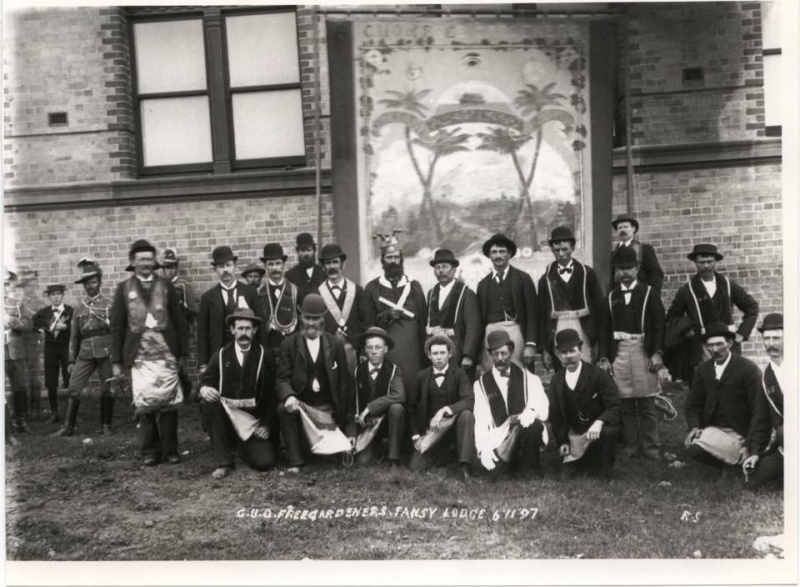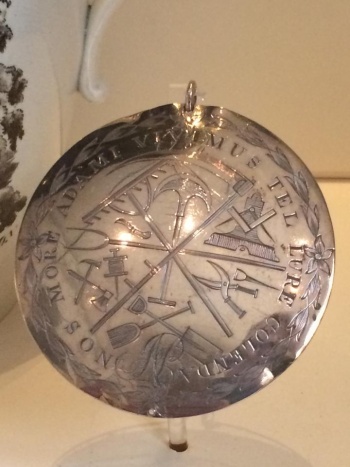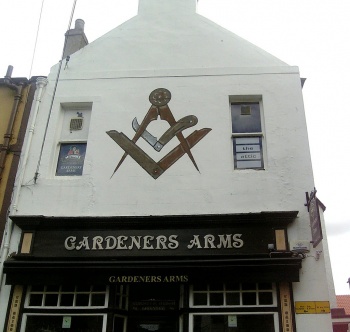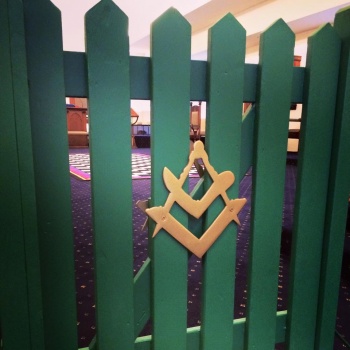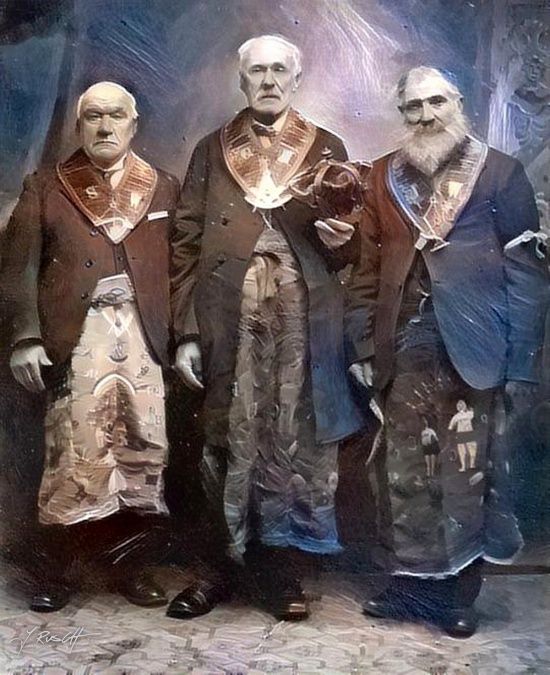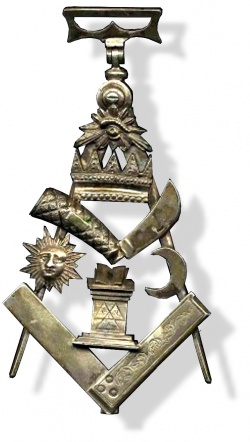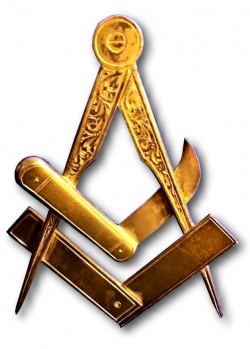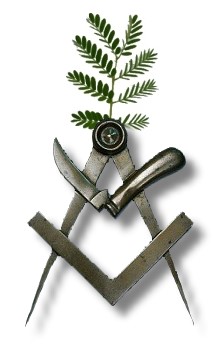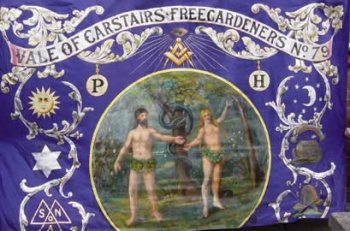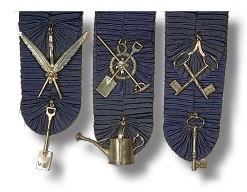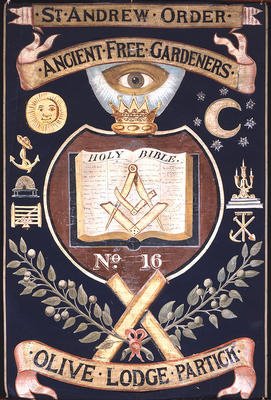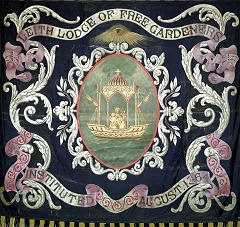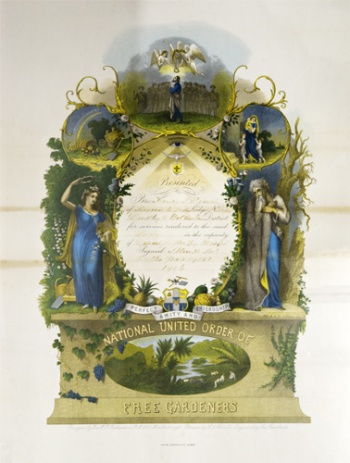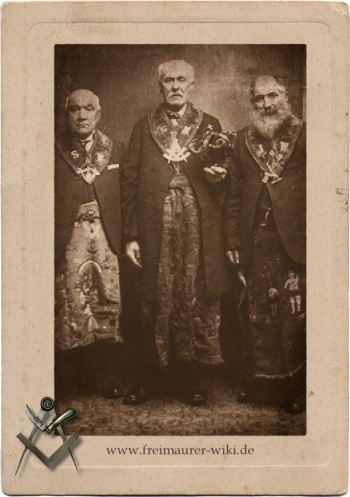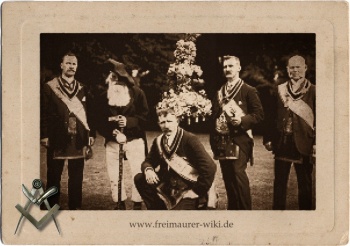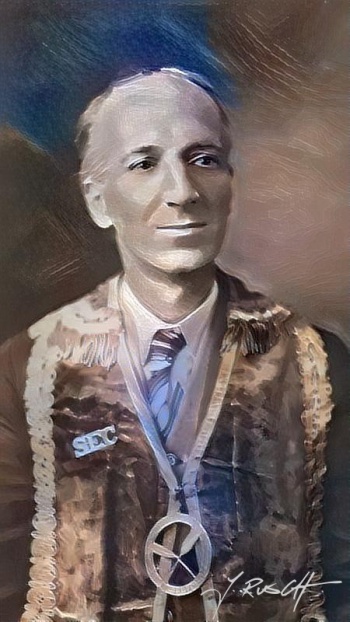Freigärtner: Unterschied zwischen den Versionen
Keine Bearbeitungszusammenfassung |
Keine Bearbeitungszusammenfassung |
||
| Zeile 76: | Zeile 76: | ||
== Siehe auch == | == Siehe auch == | ||
*[[Traktat: Parabel vom Blumengarten]] | *[[Traktat: Parabel vom Blumengarten]] | ||
[[Datei:VictoriaoptC.jpg|thumb|835|Großloge "Victoria"]] | |||
== Links == | == Links == | ||
*[http://freemasonry.bcy.ca/texts/gardeners.html Free Gardeners] | *[http://freemasonry.bcy.ca/texts/gardeners.html Free Gardeners] | ||
Version vom 12. November 2016, 14:02 Uhr
Freigärtner
"Der kleine Garten mußte der eines Freigärtners sein, kein Garten geschwollen zu einem Reich. Die eigenen Hände zu benutzen, nicht die Hände von anderen zu befehlen" Samweis Gamdschie, Der Herr der Ringe, Teil III, S. 206.
Freigärtner hatten in Schottland und England eine besondere Aufgabe in Bezug auf die Verwaltung der Kolonien in Übersee. Sie erprobten, welche Pflanzenarten für königliche Gärten und öffentliche Parkanlagen klimatologisch resistent genug sein könnten. Ohne die Freigärtner würden wir heute in Europa die Bogainvillea und viele andere Pflanzen nicht haben.
Die Geschichte der Freigärtner geht 1000 Jahre zurück auf die Gärten und Weingärten bei König Salomons neugebautem Tempel auf dem Berg Zion.
Der eigentliche Orden der Free Gardeners ist eine brüderliche Gesellschaft, die in Schottland in der Mitte des 17. Jahrhunderts gegründet wurde und sich später nach England und Irland ausbreitete. Wie zahlreiche andere befreundete Gesellschaften der Zeit, war ihr Hauptziel der Austausch von Wissen und von Geheimnissen für den Beruf und die gegenseitige Hilfe untereinander. Im 19. Jahrhundert standen dann seine Aktivitäten im Rahmen gegenseitiger Versicherung im Vordergrund. Bis zum Ende des 20. Jahrhunderts war der Orden fast ganz ausgestorben.
Im Jahre 1849 gründete sich "The Ancient Order of Free Gardeners Schottland Penicuik". Im Jahr 1956 wurde die Großloge per Charter, aufgrund der sinkenden Mitgliederzahlen in Schottland, nach Kapstadt in Südafrika übertragen und ist dort verblieben. Im September 2005 kam dann der alte Orden nach Schottland zurück, auf eine Initiative der "Gräfin von Elgin Lodge" (Elgin's Lodge at Leven No. 91 [[1]]).
Obwohl die Free Gardeners immer der Freimaurerei anhingen, entwickelten sich in diesem Licht zahlreiche Unterarten und Fachgruppen.
Ritual
Das Freigärtner-Ritual entstand in unmittelbarer Anlehnung an freimaurerische Rituale. Auch die Grade entsprechen der freimaurerischen Ordnung.
Abweichend ist jedoch die Symbolik, wie die hier gezeigten Beamtenzeichen aufweisen.
Metaphorik
Dokumente eines Logentages von 1873 zeigen auf, dass Freigärtner Bezug nehmen auf den Garten Eden und die Pflege des Bodens metaphorisch mit der Pflege des Geistes und der Tugenden in Verbindung sehen. Ein tiefer Respekt vor der Schöpfung und ein pfleglicher Umgang mit den Gaben der Natur entspricht der "Arbeit am rauhen Stein" der üblichen spekulativen Freimaurerei.
3 Grade
- 1. Grad Der Lehrling (Basiert auf Adam aus der Genesis)
- 2. Grad Der Geselle (welcher irgendwie mit der Erzählung von Noah´s Arche verbunden war)
- 3. Grad Der Meistergärtner (wird mit König Salomon gleichgesetzt)
Freigärtner in Oberschlesien
Eine Eigentümlichkeit Oberschlesiens stellten die Freigärtner oder Freileute dar. Ihren Status verdankten sie der Geldverlegenheit, in der sich Herzog Johann von Oppeln im 16. Jahrhundert einst befunden hatte.
Genannte Freigärtner
- Johann Gottfried Weimann
- Schilkowitz Krs. Wohlen 28. 05. 1833
- Gottfried Weinmann * Kendzic, Krs. Militsch, 31. 7. 1796
- Gottfried Kaulfuss Deputierter der Gemeinde Heidau
Freigärtnerlogen in Schottland/England
Stand: Dezember 2014
- Lodge No. 1 - Caledonian Thistle, Edinburgh Chartered 2002 (SCOTLAND), (Loge Nr. 1 - Kaledonische Distel, Edinburgh, gegründet 2002 in Schottland
- Lodge No 2 - Cianalas, Brora Chartered 2002(SCOTLAND), (Loge Nr. 2 - "Melancholie, [Fluss] Brora" gegründet 2002 in Schottland
- Lodge No 3 (Lodge No. 105) - The Countess of Elgin Chartered 2002, Kirkcaldy (SCOTLAND),(Loge Nr. 3 "Die Comtesse von Elgin", gegründet 2002 in Kirkcaldy (Schottland)
- Lodge No 4 - Adelphi Bluebell, Chartered 2002 Uddingston (SCOTLAND), (Loge Nr. 4 - Adelphi Glockenblume, gegründet 2001 in Uddingston (Schottland)
- Lodge No 5 - Cheshire Bluebell Chartered 2003, Cheshire (ENGLAND) Now Inactive?, (Loge Nr. 5 - Cheshire Glockenblume, gegründet 2003 in Cheshire (England) gerade inaktiv?)
- Lodge No 6 - Eden, Leuchars (SCOTLAND) Chartered 2003, (Loge Nr. 6 - Eden, gegründet 2003 in Leuchars (Schottland)
Siehe auch
Links
- Free Gardeners
- Order_of_Free_Gardeners bei Wikipedia
- Mastermason Ausführliches PDF in englischer Sprache. (Bitte übersetzen)
- Hanging Gardens of Babylon-Lodge
In englischer Sprache
Gardeners collections
Source: Historyshelf.org
Most Local History and Archive collections in the Lothians and Fife have some records about free gardeners in their area. Almost all local authority museums have some artefacts relating to individuals or lodges. Almost all these bodies have contributed material to the SHELF project. LINK
In addition to the resources on this website, much more was surveyed and can be found on Resources for Learning in Scotland, of which SHELF was just a part. Only a proportion of the existing gardeners' records were selected for inclusion because SHELF looked at the whole idea of self-help. The material that was included can lead back to the original collections held in museums, libraries and archives across the Lothians and Fife.
Other significant collections are held in national institutions. Many records have been deposited in the National Library of Scotland. The National Archives of Scotland have the holdings acquired by the Registrar of Friendly Societies and other deposits. For example, records relating to the Ancient Fraternity of Free Gardeners of East Lothian from 1676-1953 are held under reference GD420. Some university libraries also have material of interest.
However, much is still tucked away in cupboards in homes or lying forgotten in halls and club-rooms awaiting discovery.
The Literature of Free Gardening
A good starting point to discover what is in your area is the survey by Ian MacDougall published as A Catalogue of some Labour Records in Scotland and some Scots Records outside Scotland (Scottish Labour History Society, Edinburgh, 1978). A recent survey of the Free Gardeners was researched and published by Robert Cooper as An Introduction to the Origins and History of the Order of Free Gardeners (Q.C. Correspondence Circle Ltd., London, 2000). Early Scottish Gardeners and their Plants 1650-1750 (Tuckwell Press, East Linton, 2000) by Forbes W Robertson contains a chapter on gardeners societies. Your local library will be able to find copies of all these books.
Some lodges included short histories in their booklets of rules and regulations or have been the subject of a local study. For example, both Dunfermline and Haddington are the subjects of short accounts: History of the Society of Gardeners in Dunfermline by anon (A Angus, Dunfermline, 1816) and the Ancient Fraternity of Free Gardeners of East Lothian by Charles Martine and WH Brown (ed.) (East Lothian Antiquarian and Field Naturalists' Society, Haddington, 1975).
However, rulebooks have only survived by chance and your lodges may have left no record. Many documents relating to Gardeners are catalogued along with material relating to Freemasonry.
Your local press is often a good source to build a picture of Gardeners' business and social activities. Many local papers have been microfilmed and are available in local history centres. Directories and annual registers often list lodges, addresses and office holders.
History
The history of Free Gardeners originated thousands of years ago in the vineyards and gardens of King Solomon's newly built temple on Mount Zion.
As the work completed, the operative Gardeners went in search for new employment, where they were often helped by fellow Gardeners whom they encountered on their travels.
Over time, a bonded fellowship developed that enabled members to rely on other members for protection, assistance and benevolence. They became the Order of Free Gardeners.
In the 19th century this fellowship morphed into a concept known as Friendly Societies. The Grand United Order of Free Gardeners Friendly Society provided medical, funeral benefits, and loans for educational or housing expenses as well as providing a Fraternal Lodge for like minded men. During this time the Order were able to help thousands of families throughout the turn of the century, the Great Depression, two world wars and into the 21st century.
In 2006 the Australian Prudential Regulation Authority removed all of their financial responsibilities.
Even after the closure of the Friendly Society, the strength of the friendships and brotherhood made at the Victorian Lodge No. 1 continued, and today remains the only Free Gardeners Lodge in Australia and the Southern Hemisphere. The year 2014 marks a milestone in the Orders history in celebrating 150 years of Free Gardenry in Australia.
The Victorian Lodge No. 1 meets on the 2nd Wednesday of the month (January excluded) at the Box Hill Masonic Center, 1013 Whitehorse Rd, Box Hill, Victoria, Australia.
Membership is open to men who are 21 years or older, who are permanent Australian residents, residing in Victoria. Further requirements to join are obtainable from the Grand Secretary.
Free Gardeners are law abiding citizens who enjoy the friendship and sense of belonging offered by community of like minded individuals. If you are interested in joining the Grand United Order of Free Gardeners, making new friends, and in doing so preserving Australia's fraternal history, expressions of interest are welcome by contacting the Grand Secretary.
guofgvic1@gmail.com
Pictures


